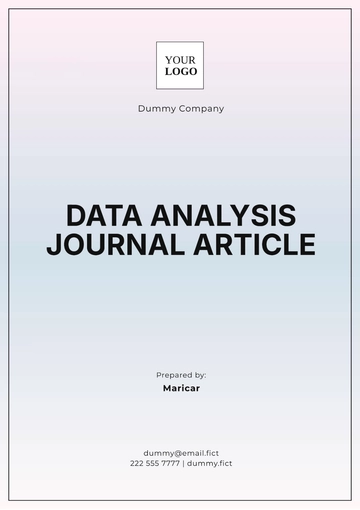Free Law Firm Financial Analysis

I. Introduction
[Your Company Name] is a prominent law firm specializing in various legal areas. As part of our commitment to excellence and transparency, we have conducted a comprehensive financial analysis to evaluate our firm's performance and identify opportunities for improvement. This report provides an in-depth examination of our financial health and key findings for the fiscal year ending December 31, 2023.
II. Profitability Analysis
In the fiscal year 2023, [Your Company Name] achieved a total revenue of $12.5 million, representing a significant 15% increase from the previous year. The breakdown of revenue sources is detailed below:
Revenue Source | Amount (USD) |
|---|---|
Billable Hours | $8.2 million |
Contingency Fees | $2.5 million |
Retainers | $1.2 million |
Other Income | $0.6 million |
Total Revenue | $12.5 million |
Billable Hours: Billable hours represent the core revenue-generating activity for our firm. In the fiscal year 2023, billable hours contributed the highest proportion to our total revenue, amounting to $8.2 million. This indicates the significant contribution of our attorneys' expertise and services to our firm's financial performance.
Contingency Fees: Contingency fees, totaling $2.5 million, reflect the revenue earned from legal matters where payment is contingent upon successful outcomes. While representing a substantial portion of our revenue, contingency fees can be subject to variability depending on the outcomes of legal cases.
Retainers: Retainers, amounting to $1.2 million, represent upfront payments made by clients to secure ongoing legal services. Retainers provide a steady source of revenue and demonstrate the trust and commitment of our clients to our firm.
Other Income: Other income, totaling $0.6 million, encompasses miscellaneous revenue streams such as referral fees, interest income, and ancillary services. While representing a smaller portion of our total revenue, these additional income streams contribute to our firm's overall financial diversification.
III. Billing and Collection Analysis
Efficient billing and collection processes are essential for maintaining positive cash flow and maximizing revenue realization. Our analysis reveals the following metrics for the fiscal year:
Metric | Value |
|---|---|
Average Billing Cycle | 45 days |
Collection Rate | 85% |
Average Billing Cycle: The average billing cycle of 45 days indicates the average time it takes for our firm to invoice clients for services rendered. While this metric is within an acceptable range, reducing the billing cycle to 40 days, as targeted for the next fiscal year, will enhance cash flow and liquidity by accelerating the conversion of billable work into invoiced revenue. Shortening the billing cycle also fosters better client relationships by providing timely and transparent billing information.
Collection Rate: With a collection rate of 85%, [Your Company Name] successfully collected 85% of invoiced amounts from clients during the fiscal year. While this rate demonstrates effective collection practices, increasing the collection rate to 90%, as aimed for the next fiscal year, will further improve cash flow and minimize outstanding accounts receivable. Enhanced collection efforts, such as proactive follow-up on overdue payments and implementing payment incentives or options, will contribute to achieving this target.
IV. Utilization and Realization Rates
The table below illustrates [Your Company Name]'s utilization and realization rates for billable hours during the fiscal year ending December 31, 2023:
Metric | Rate |
|---|---|
Utilization Rate | 70% |
Realization Rate | 80% |
Utilization Rate (70%): The utilization rate measures the percentage of billable hours worked by our attorneys compared to their total available hours. With a utilization rate of 70%, our firm effectively utilized 70% of the available time for billable work during the fiscal year. While this rate demonstrates a reasonable level of productivity, there is room for improvement to maximize the utilization of billable hours. Strategies to increase the utilization rate may include optimizing workflow processes, enhancing time management practices, and aligning staffing levels with client demand.
Realization Rate (80%): The realization rate indicates the percentage of billable hours that were successfully billed to clients and converted into revenue. With a realization rate of 80%, [Your Company Name] captured 80% of billable hours worked as revenue during the fiscal year. While this rate reflects effective billing practices, there is an opportunity to enhance revenue capture by improving billing accuracy, promptly invoicing clients for billable work, and minimizing unbillable hours. Increasing the realization rate to 85%, as targeted for the next fiscal year, will contribute to maximizing revenue generation and financial performance.
V. Financial Ratios
The financial ratios demonstrate our firm's effective utilization of resources to generate returns for shareholders, as well as our conservative approach to debt management. The table below presents key financial ratios for [Your Company Name] for the fiscal year ending December 31, 2023:
Financial Ratio | Value |
|---|---|
Return on Investment (ROI) | 25% |
Return on Equity (ROE) | 30% |
Debt-to-Equity Ratio | 0.5 |
Return on Investment (ROI) - 25%: The return on investment ratio measures the efficiency of [Your Company Name]'s ability to generate returns from investments made in the business. With an ROI of 25%, our firm generated $0.25 in profit for every dollar invested. This indicates that [Your Company Name] effectively utilized its resources to generate favorable returns for shareholders. A higher ROI reflects better profitability and indicates that our firm is efficiently utilizing its assets to generate income.
Return on Equity (ROE) - 30%: The return on equity ratio evaluates [Your Company Name]'s ability to generate profits from shareholder equity. With an ROE of 30%, our firm generated $0.30 in profit for every dollar of shareholder equity. This ratio indicates that [Your Company Name] is generating strong returns for its shareholders relative to the equity invested in the business. A higher ROE signifies efficient utilization of shareholder funds and reflects positively on our firm's financial performance.
Debt-to-Equity Ratio - 0.5: The debt-to-equity ratio measures [Your Company Name]'s leverage and financial risk by comparing its debt to shareholder equity. With a debt-to-equity ratio of 0.5, our firm has $0.50 of debt for every dollar of equity. This indicates a conservative approach to financing, as our firm relies more on equity financing than debt financing to fund its operations and growth initiatives. A lower debt-to-equity ratio suggests lower financial risk and greater financial stability, as it indicates that [Your Company Name] has a relatively low level of debt compared to its equity.
VI. Financial Forecasting and Budgeting
Based on our analysis, we have developed the following financial forecasts and budgets for the fiscal year 2024:
Financial Metric | Amount (USD) |
|---|---|
Revenue Forecast | $14 million |
Expense Budget | $10 million |
Profit Projection | $4 million |
Revenue Forecast - $14 million: The revenue forecast of $14 million for the fiscal year 2024 represents a targeted increase from the previous year, reflecting anticipated growth in client demand and expanded service offerings. This forecast is based on thorough market analysis, client projections, and historical performance trends. Achieving this revenue target will require proactive client engagement, effective marketing strategies, and superior service delivery to capitalize on growth opportunities in our target markets.
Expense Budget - $10 million: The expense budget of $10 million outlines the anticipated expenditures required to support [Your Company Name]'s operations, including personnel costs, overhead expenses, marketing initiatives, technology investments, and other operating expenses. Careful consideration has been given to cost control measures and efficiency improvements to ensure that expenses are managed effectively while maintaining service quality and operational efficiency.
Profit Projection - $4 million: The profit projection of $4 million represents the expected net income for [Your Company Name] in the fiscal year 2024 after deducting expenses from forecasted revenue. This projection reflects our firm's focus on achieving sustainable profitability while reinvesting in strategic initiatives to drive long-term growth and competitiveness. Achieving this profit target will require disciplined financial management, cost containment measures, and revenue optimization strategies to maximize profitability and shareholder value.
VII. Client and Matter Analysis
Client and Matter Analysis is an integral part of [Your Company Name]'s strategic approach to financial management and client relationship management. By delving into the details of our client engagements and practice areas, we gain valuable insights that inform decision-making and drive performance improvement. Here's a breakdown of our analysis:
Client Segmentation: [Your Company Name] categorizes clients into segments based on various criteria such as revenue contribution, industry sector, geographic location, and engagement type. This segmentation allows us to identify our most profitable client segments and tailor our services to meet their specific needs. For example, we may find that clients in the technology sector contribute the highest revenue and require specialized legal expertise, prompting us to allocate more resources to this segment.
Matter Profitability: We analyze the profitability of individual matters by examining factors such as revenue generated, hours billed, expenses incurred, and profit margins. By assessing matter profitability, we can identify areas of strength and weakness within our practice areas. For instance, we may discover that litigation matters yield higher profit margins compared to transactional work, prompting us to adjust our resource allocation and pricing strategies accordingly.
Client Retention and Acquisition: [Your Company Name] tracks client retention rates and new client acquisition metrics to gauge the effectiveness of our client relationship management and business development efforts. By analyzing client satisfaction levels, referral rates, and client lifetime value, we can identify opportunities to strengthen client relationships and drive organic growth. For example, if we observe a decline in client retention rates, we may implement initiatives to enhance client satisfaction and loyalty, such as personalized client outreach or value-added services.
Practice Area Performance: We evaluate the performance of different practice areas based on metrics such as revenue contribution, profitability, growth trends, and market demand. This analysis enables us to identify areas of opportunity and allocate resources strategically. For instance, if we notice a surge in demand for intellectual property services, we may invest in expanding our IP practice group to capitalize on this growth opportunity.
Key Performance Indicators (KPIs): [Your Company Name] monitors key performance indicators such as client profitability, matter realization rates, client satisfaction scores, and matter turnaround times. These KPIs provide insights into our operational efficiency and service quality, allowing us to identify areas for improvement. For example, if we observe a decline in matter realization rates, we may implement measures to enhance billing accuracy and improve collections processes.
Trends and Forecasts: We analyze trends in client and matter metrics over time to identify patterns, opportunities, and risks. By forecasting future demand for legal services and client needs, we can proactively adapt our business strategies and resource allocation to stay ahead of the curve. For instance, if we anticipate a shift in market demand towards environmental law, we may develop targeted marketing campaigns to attract clients in this area.
VIII. Conclusion
In conclusion, [Your Company Name] has demonstrated strong financial performance in the fiscal year 2023. By focusing on enhancing profitability, optimizing billing and collection processes, improving utilization and realization rates, and implementing effective financial management strategies, we are well-positioned for continued success and growth in the legal industry. We remain dedicated to delivering exceptional value to our clients while maximizing shareholder returns.
- 100% Customizable, free editor
- Access 1 Million+ Templates, photo’s & graphics
- Download or share as a template
- Click and replace photos, graphics, text, backgrounds
- Resize, crop, AI write & more
- Access advanced editor
Gain a comprehensive view of your law firm's financial health with Template.net's Law Firm Financial Analysis Template. Editable in our AI Editor Tool, this customizable template provides a structured format for analyzing key financial metrics, such as revenue, expenses, profitability, and cash flow. Enhance financial visibility, identify trends, and make informed decisions effortlessly with Template.net!





























